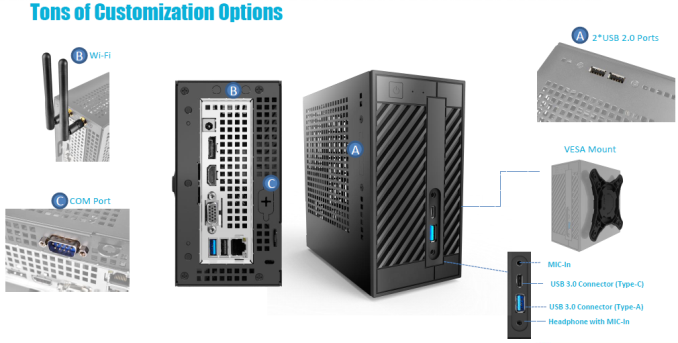ASRock DeskMini 110 mini-STX PC Review
by Ganesh T S on June 8, 2016 8:45 AM ESTConcluding Remarks
The ASRock DeskMini 110 gave us the opportunity to check out what is possible with the mini-STX form factor and a high-TDP Skylake CPU. It is quite clear that Intel's current marketing angle with the mini-STX form factor is affordability. Otherwise, it is difficult to explain why almost all vendors have gone in for a H110 chipset-based design for their mini-STX offerings. That said, ASRock has put in a couple of good differentiating aspects in the DeskMini 110: support for 65W TDP CPUs and a M.2 PCIe slot for SSDs directly connected to the CPU's PCIe lanes. This works around the issue of the H110 chipset having only PCIe 2.0 lanes
The pricing is very competitive - $130 for the all-metal chassis, 120W power adapter and cord, and the H110 motherboard. While the assembly is not as easy as that of a NUC, it is acceptable for the DIY market.
In terms of scope for improvement, a bundled WLAN adapter would be very welcome. Sourcing one that can fit in with the chassis design will be a challenge, as most M.2 PCIe WLAN modules are either meant for NUCs, or for notebooks. The DeskMini's all-metal chassis makes it difficult to get a suitable placement for the flat antennae that come with such WLAN adapters. I think it would be better for ASRock to bundle / pre-install a WLAN module and antennas for a slight increase in the price of the product. The DeskMini could also do with some additional I/O (say, a SD card reader).
It is great to see the mini-STX form factor getting broad vendor support. We would like it more if vendors were able to differentiate their offerings. ASRock has tried out a few things differently in the storage subsystem and chassis design with the DeskMini 110. We look forward to seeing what other differentiation aspects come out in the future iterations in this product line.












85 Comments
View All Comments
r3loaded - Wednesday, June 8, 2016 - link
Yeah, MXM was invented to make life easy for OEMs, not consumers.Flunk - Wednesday, June 8, 2016 - link
I think the ship has sailed on that idea, people want smaller and smaller notebooks, not huge ones with huge upgradability.CharonPDX - Wednesday, June 8, 2016 - link
Heck even a transverse (on a riser, across the top of the CPU,) half-height, short-length PCIe x16 slot would be nice, there are "decent", (although not "super powerful) video cards available for half-height, short-length slots.Valantar - Wednesday, June 8, 2016 - link
Thunderbolt 3 alongside similarly sized (stackable?) (MXM-based) external GPUs would be better. Want a small system with just what you need for office/HTPC duty? Skip the GPU. Want a compact gaming rig? Get the extra chassis and (given proper availability and firmware standardization) whatever MXM GPU you want. You could easily fit the "MXM+" GTX 980 (and thus 1080, whenever it's out) in a 5" by 5" form factor, and cooling would be a breeze with a heatsink filling two dimensions of the chassis fitted with a downward blowing 120mm fan.marc1000 - Thursday, June 9, 2016 - link
MXM has lots of issues.I believe if you wanna go this small, it is better to stick with NUCs. if you need some more power, go for mITX + standard GPU.
Calista - Sunday, June 12, 2016 - link
Problem is a mITX case could easily handle a 1000 watt system, going with a full-sized ATX PSU and a high-end GPU/CPU combo and a large bunch of drives. It would be noisy when going full tilt, but it would be doable. What people seem to be asking for is a <200 watt tiny system with interchangeable parts. A 200 watt TDP would allow for a small but efficient PSU to fit within a small case, a 65W CPU and a 100 watt GPU, meaning even a modern high-end GPU like the GTX 970.The mSTX form factor just sounds like the answer to a question no one has asked.
repoman27 - Friday, June 10, 2016 - link
The switch to HBM and stacking the memory and GPU on interposers will enable socketed GPUs in near future. Hopefully that becomes a thing.Namisecond - Wednesday, July 6, 2016 - link
You'd have the same problems with MXM there as you do with them on laptops, with maybe marginally more volume for a cooling system.MXM was not designed to be a user serviceable interface. The sooner you realize that, the happier you'll be. :3
SeanFL - Wednesday, June 8, 2016 - link
Glad to see more vendors gearing up in the small space PC's. Have changed over to NUC's and other small form factors in the house and at work and they work fantastic for almost everything. The monster 6 core machine (i7-5930k) only gets used for video editing now.blackice85 - Wednesday, June 8, 2016 - link
Agreed, I'm glad that these have become pretty viable now. I'm looking to replace my big PC with a smaller machine as well, but would like to still do some medium-ish quality gaming on occasion. I'm hoping the new AMD Zen APUs next year fit the bill, I'll have to see how they review. It would just be cool if a discrete GPU wasn't really a requirement anymore.